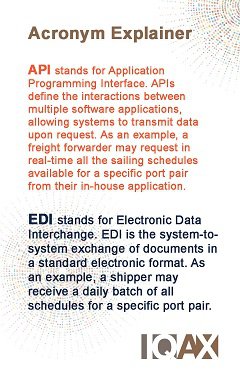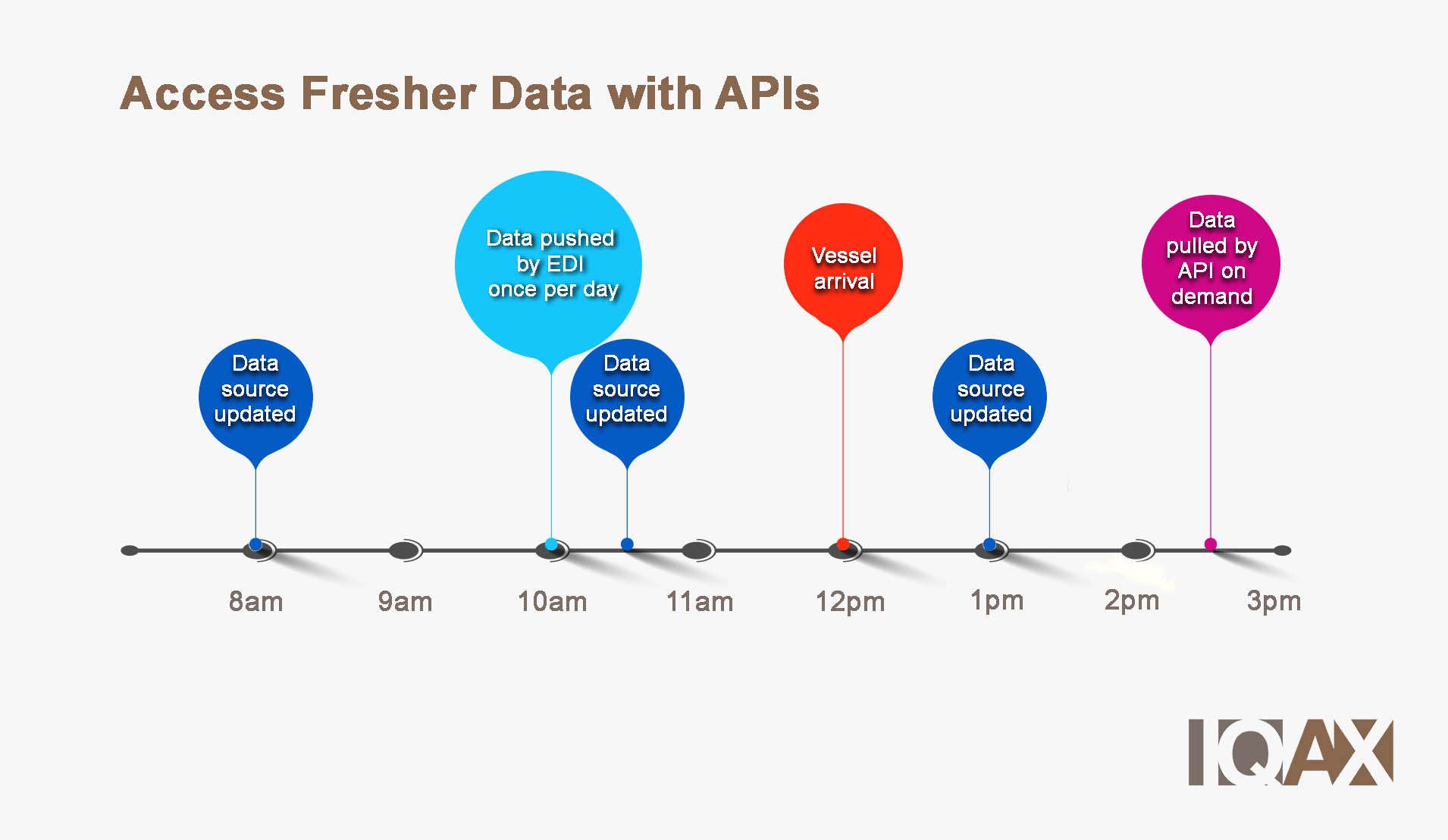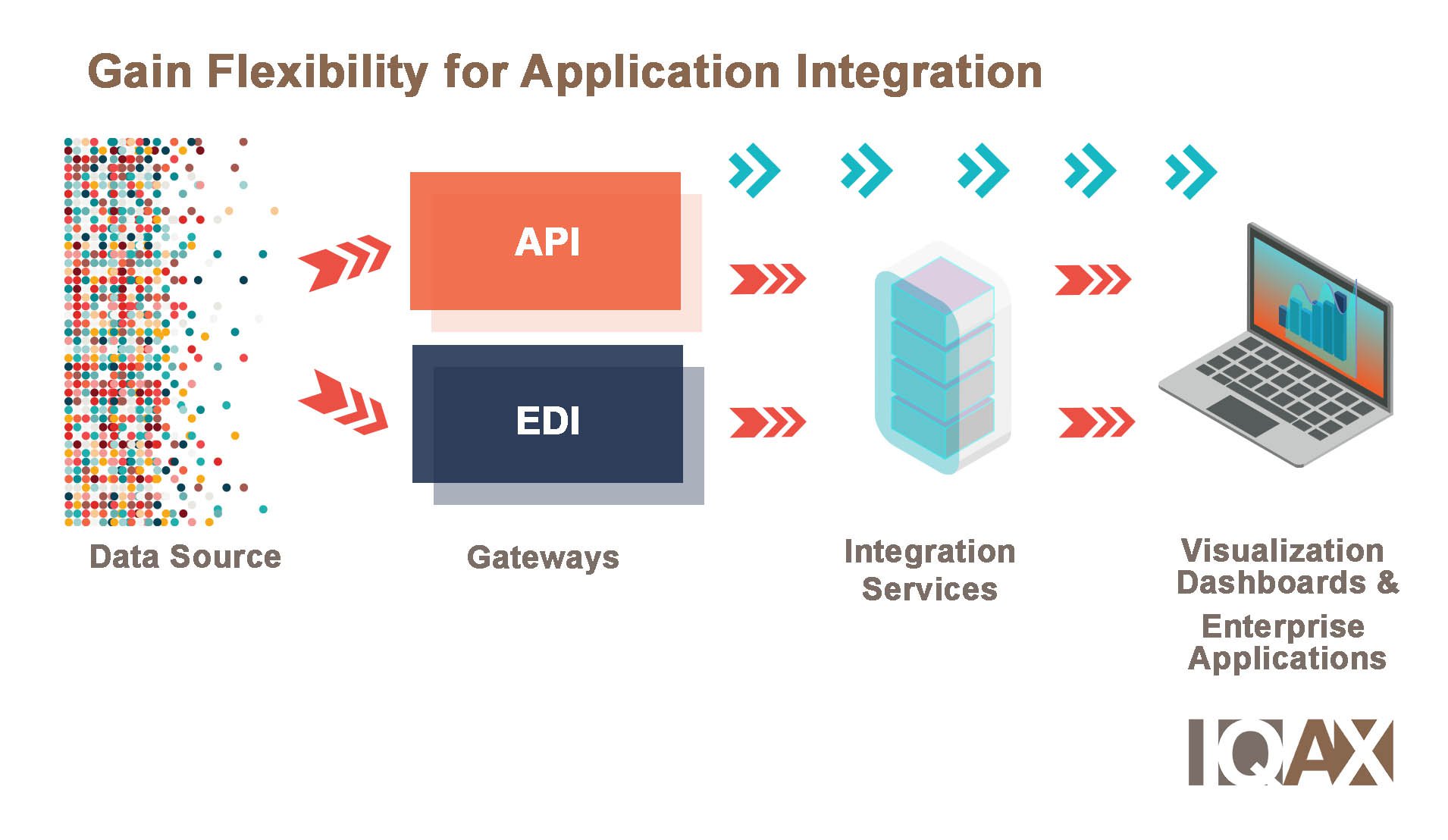The API Advantage for Sailing Schedule Integration
If you have access to quality schedule data for supply chain planning or for supporting your shipper customers, what's the best way to integrate it with your system? And what's all the hype about APIs? Learn three reasons why shippers and forwarders prefer APIs over EDI for accessing schedule data.
➔ Want to try sailing and vessel schedule APIs? Start your free trial.
Seeking Ways to Integrate Schedule Data for Supply Chain Planning
While the pandemic has limited global travel, increased remote work, and driven investment for contactless technologies, the need to digitalize to keep products moving and serving customers online is greater than ever. One piece of the digital puzzle is how to access quality sailing and vessel schedule data that you can incorporate into your in-house applications to improve planning and visibility.
Going to a website daily and re-entering the data in your system is one way. However, this is very time consuming and prone to errors. If you are considering system-to-system integration, then APIs and EDI are options that can save you effort.
Have you wondered what the difference is between APIs and EDI for integration of shipping information? Did you consider EDI in the past for schedule data, but realized it was not manageable? And, what advantages does the more modern API offer?
API and EDI Integration Considerations

To begin, API stands for Application Programming Interface. APIs define the interactions between multiple software applications, allowing systems to transmit data upon request.
APIs have grown in popularity since the early 2000s, fueled by the increased use of Software as a Service web applications. They are available for both sailing schedules and vessel schedules. Sailing schedule APIs send schedules for vessels that have not yet departed for a specific port pair to plan for upcoming shipments. Vessel schedule APIs send schedules for vessels that have started their journey for the specific port pair to help you track actual movements and route plans.
EDI, or Electronic Data Interchange, is the system-to-system exchange of documents in a standard electronic format. It offers an established structured syntax message set that encompasses both sailing schedules and vessel schedules, called the ANSI-X.12 EDI 323 – Vessel Schedule and Itinerary for ocean shipping. While there is a standard, it can be customized. Although, customization adds effort and cost to tailor the message to each system.
While businesses have been following EDI standards since the 1980s, it presents challenges. Many companies have opted not to use the EDI sailing schedule data because it generates a lot of data that can be costly and cumbersome to manage.
The API Advantage for Ocean Shipping Data
Understanding the schedule data that you can access and how it is in sync with your carriers' data and enhanced with AIS live vessel data for actual departure and arrival times is the first step. Once you understand the data you are working with, tapping into your data sources using APIs, rather than EDI, for schedule data provides numerous advantages for your in-house applications that can leverage the APIs.
One fundamental difference is that APIs enable you to pull data from your source on-demand. EDI on the other hand uses a push mechanism. EDI messages are sent at regular intervals from the source to your system, whether it's weekly, daily, or particular changes occur in the data.
Based on this underlying difference, here are three ways that APIs have an advantage over EDI:
1. Less data latency - By pulling the data the moment you need it, you are pulling the latest possible data from the source. For example, if you receive an EDI message update once a day at 10am, the vessel arrives at berth at noon, but you look up whether a vessel has arrived at its destination at 2pm in the afternoon so that you can issue an invoice and tighten your cash-to-cash cycle time, your EDI data will not show that the vessel has arrived. If you had pulled the data in the afternoon by API, you would have the most current information to know that the vessel had arrived.

2. Less data to manage - If you need schedules to track all possible vessels on a specific trade lane or all possible schedules to make a booking on multiple trade lanes, you may need to manage a tremendous about of data if you receive all schedules on a regular basis by EDI. On the other hand, if you pull the schedules as you need them by APIs, not only are you accessing the latest available data, you only pull the schedules you need at that moment, likely reducing the amount of incoming data that you need to store, maintain, and manage.

3. Easier application integration – APIs allow information to be directly represented in your internal analytics dashboards, such as Microsoft Power BI or Tableau, and provide real-time updates about what is happening. They also offer the possibility of integrating with critical enterprise systems. If your applications pull data from the source by APIs, you can pull data according to your timing, processes and needs. It's a more flexible process to be able to request and consume the data on demand. APIs are easier to integrate because they can bypass error-prone processing steps, while EDI requires a lot more work integrate.

By working with APIs, you have the most current data for your applications for greater transparency and accuracy, you can access the data you really need, and your applications can pull data from the source.
API Benefits Beyond Schedule Data
The benefits of schedule APIs extend to other ocean-related APIs as well. Whether you want to extract schedule or tracking information at the vessel level or down to your container level, APIs can make integration and management more timely and easier.
Getting Started: Trying Out Schedule APIs
The best way to understand APIs and how you may be able to work with them is to review the API specification guides to see the data elements and parameters offered and to request a sample API to test it with your systems.
IQAX Big Schedules provides APIs for 27 major ocean carriers’ sailing schedules and vessels schedules. Through API integration, you can gain access to accurate schedules from multiple sources, including the latest vessel route and schedule information.
We invite you to sign up for a 14-day free trial today to explore how schedule data can improve your supply chain processes.
Start API Free Trial
Related Topics:


